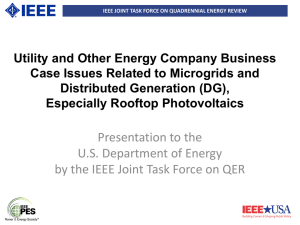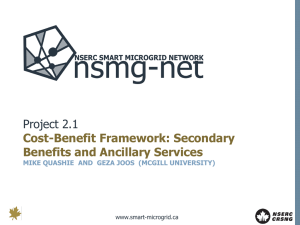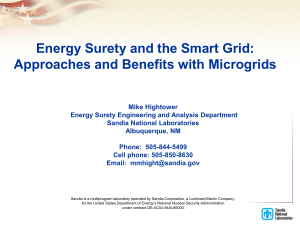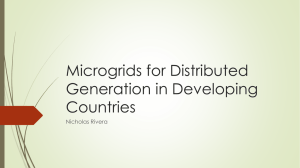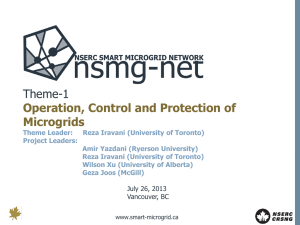Microgrids - IEEE-USA
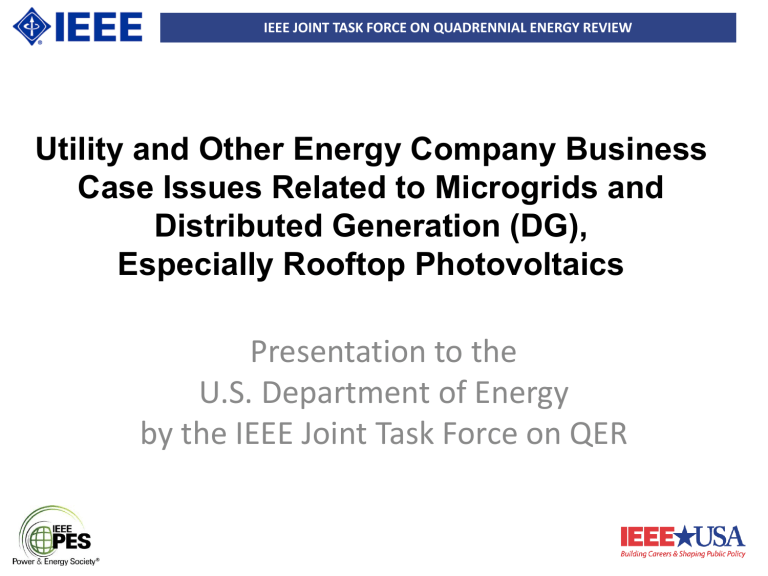
Utility and Other Energy Company Business
Case Issues Related to Microgrids and
Distributed Generation (DG),
Especially Rooftop Photovoltaics
Presentation to the
U.S. Department of Energy by the IEEE Joint Task Force on QER
IEEE JOINT TASK FORCE ON QUADRENNIAL ENERGY REVIEW
Microgrids defined
• A microgrid is a group of interconnected loads and distributed energy resources within clearly defined electrical boundaries that acts as a single controllable entity with respect to the grid
• A microgrid can connect and disconnect from the grid to enable it to operate in both grid-connected or island mode
2
IEEE JOINT TASK FORCE ON QUADRENNIAL ENERGY REVIEW
U.S. DOE requested insights on:
• Utility and other energy company business case issues related to microgrids and distributed generation (DG), esp. rooftop photovoltaics (PV)
• DOE has funded microgrid deployment to improve storm resilience but wants to ensure that utilities see microgrid benefits
• DOE would like to evaluate the quantifiable benefits for microgrids and how to achieve them
3
IEEE JOINT TASK FORCE ON QUADRENNIAL ENERGY REVIEW
Findings
• Microgrids can provide quantifiable benefits for utilities, their customers, and energy service companies, regardless of ownership
• Microgrids and DG introduce operational challenges that utilities must address
• Developing a positive business case for microgrid sponsorship depends on many variables, including the evolution of technology, policy, and standards
4
IEEE JOINT TASK FORCE ON QUADRENNIAL ENERGY REVIEW
Utilities will likely address microgrids based on market drivers
• PV uptake by customers is increasing, due to incentives, improved performance, lower cost
• State-level PV incentives are powerful drivers
• Large utility customers increasingly seek reliability, autonomy, cost certainty, resilience
• Large utility customers, including military bases, universities, schools , hospitals, and corporate campuses seek microgrids for energy surety
5
IEEE JOINT TASK FORCE ON QUADRENNIAL ENERGY REVIEW
PV uptake is increasing
Source: Solar Energy Industries Association ®
6
IEEE JOINT TASK FORCE ON QUADRENNIAL ENERGY REVIEW
Policy incentives are powerful drivers
Source: Solar Energy Industries Association ®
7
IEEE JOINT TASK FORCE ON QUADRENNIAL ENERGY REVIEW
Microgrids deliver value to utility customers
Source: S&C Electric Company
8
IEEE JOINT TASK FORCE ON QUADRENNIAL ENERGY REVIEW
Minnesota study found high potential microgrid uptake
• A 2013 study commissioned by the Minnesota
Department of Commerce revealed high microgrid
“applicability” to > 600 facilities among hospitals, universities, nursing homes, and prisons, among others
• The potential load served by microgrids for these facilities is >1.4 million MWh/year
• This reflects a potential loss of sales by incumbent utilities that serve these facilities
9
IEEE JOINT TASK FORCE ON QUADRENNIAL ENERGY REVIEW
Total microgrid capacity forecast:
North America leads global growth
Source: Navigant Research
10
IEEE JOINT TASK FORCE ON QUADRENNIAL ENERGY REVIEW
Microgrids, DG and operational issues
• PV/non-utility microgrids shift a centralized, one-way power system to a bidirectional system with new supply and load variables at the grid’s edge
• Resulting operational issues include the nature, cost and impact of interconnections, voltage stability, frequency regulation, and personnel safety
• A grid and microgrid must be integrated – not just connected
– as a hybrid grid
– Transmission provides pathways for the transport of clean energy between resource and demand centers, fortifying electric system efficiency and stability and reliability of supply
11
IEEE JOINT TASK FORCE ON QUADRENNIAL ENERGY REVIEW
Microgrid benefits
• Managing high DG/PV uptake
• Deferring capital investment in added capacity
• Managing problematic circuits
• Addressing localized load growth
• Offering customers different service options
• Meeting EE, RPS mandates, emissions limits
12
IEEE JOINT TASK FORCE ON QUADRENNIAL ENERGY REVIEW
Positive business case includes technology, policy, standards
• A positive microgrid business case depends on apportioning quantifiable benefit streams against costs among all stakeholders
• Developments in technology, policy, and standards must address the emerging needs of a hybrid grid.
• Policy must reward utilities for providing customer value, not just infrastructure investment and volumetric sales. Rates must reflect true microgrid costs
• Enable a utility to envision a future-oriented business model that includes new product and service offerings and favors partnerships over customer “ownership”
13
IEEE JOINT TASK FORCE ON QUADRENNIAL ENERGY REVIEW
Recommendations: Technology
• Continue offering technology roadmaps and R&D investments (e.g., via U.S. DOE/DoD, national labs and selected pilot projects) to foster microgrid implementation
• Continue sponsoring R&D in power electronics applications (e.g., load tap changers, grid edge controllers), protection schemes, and microgrid controls to address operational challenges, including voltage and frequency regulation, from high penetration of DG
14
IEEE JOINT TASK FORCE ON QUADRENNIAL ENERGY REVIEW
Recommendations: Policy
• A state-level, results-oriented regulatory approach that rewards utilities for adopting innovations that benefit their customers may encourage microgrid adoption
• States with a restrictive definition for DG capacity for interconnection requirements should expand that definition to accommodate microgrids
• FERC’s small generator interconnection procedures
(FERC Order 2006) are relevant and may need revision
15
IEEE JOINT TASK FORCE ON QUADRENNIAL ENERGY REVIEW
Recommendations: Standards
(see also Intermittency of Renewables)
• DG proliferation (incl. PV) depends on revisions to IEEE
1547, which governs how DG is connected to the grid
• SGIP 2.0, Inc. leads an effort to identify gaps in standards via its Priority Action Plans to coordinate the work of standard development organizations on Smart
Grid standards
• Federal support of the above is welcome
16
IEEE JOINT TASK FORCE ON QUADRENNIAL ENERGY REVIEW
Summary Recommendations
• Policy should support value creation, with results-based rewards, and not unduly favor either incumbent utilities or non-utility microgrid sponsors
– Assessing costs should include efficiency, reliability, safety, optimizing lifecycle costs, and resilience for the grid
– Costs and benefits must be apportioned to each relevant party in a multistakeholder microgrid business case to accelerate microgrid adoption
– Regulatory policy must be reviewed and revised to reward a utility for the costs incurred in planning, operational changes, and the optimal integration of these customer- or utility-owned assets
• Utilities need to review where and how best to accommodate microgrids and DG given existing policy
• Utility business case-, operations- and safety-related lessons learned from utility-sponsored microgrids developed with U.S. DOE participation should be documented and disseminated
17
IEEE JOINT TASK FORCE ON QUADRENNIAL ENERGY REVIEW
IEEE REPORT TO DOE QER
ON PRIORITY ISSUES www.ieee-pes.org/qer
18
